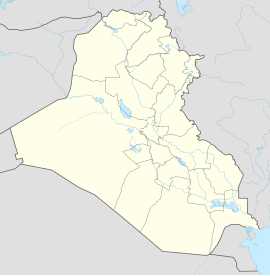Halabja
| Halabja | ||
|---|---|---|
| location | ||
|
|
||
| Coordinates | 35 ° 11 ′ N , 45 ° 59 ′ E | |
| Country |
|
|
| Autonomous Region | Kurdistan | |
| Governorate | as-Sulaimaniyya | |
| Basic data | ||
| Residents | 57,000 | |
| View of Halabja | ||
Halabja ( Kurdish ههڵهبجه, Helebce; Arabic حلبجة, DMG Ḥalabǧa ) is a city in the autonomous region of Kurdistan in Iraq with about 57,000 inhabitants. It is located about 240 km northeast of Baghdad and 14-16 km from the border with Iran in the Halabja Governorate , of which it is the capital. It is mainly inhabited by Kurds .
history
Halabja became known worldwide after the city was bombarded with poison gas by the Iraqi air force on March 16, 1988, at the end of the First Gulf War of Iraq against Iran . At least 3,200 people were killed in the massacre using various chemical warfare agents, including mustard gas and sarin .
On July 12, 1988, the Iranian troops evacuated Halabja without a fight and in return the Iraqi troops evacuated the Iranian district of Naft-e Shah.
The Halabja region was controlled by the radical Islamic terrorist group Ansar al-Islam until the US attack on Iraq in 2003 .
At commemorative ceremonies on March 18, 2006, a crowd of Kurdish youth protested against corruption in front of the Halabja monument, which commemorates the poison gas attack. During the protest, the crowd broke into the monument, ravaged it, and then set it on fire. The regional PUK government suspected Islamists to be behind the devastation.
Personalities
- Abdullah Goran (1904–1962), poet
- Salaheddine Bahaaeddin (born 1950), politician
- Sirwan Abdullah Hussein (* 1940), head of government of the Kurdish Autonomous Region
Individual evidence
- ^ Dilip Hiro: The Longest War. The Iran-Iraq Military Conflict. Routledge, New York 1991, ISBN 0-415-90407-2 , p. 228.


